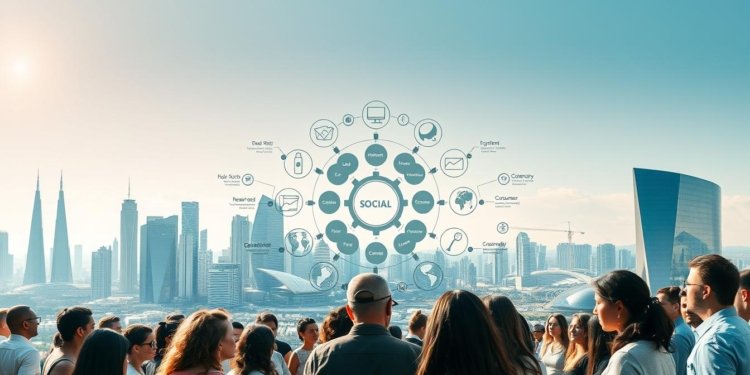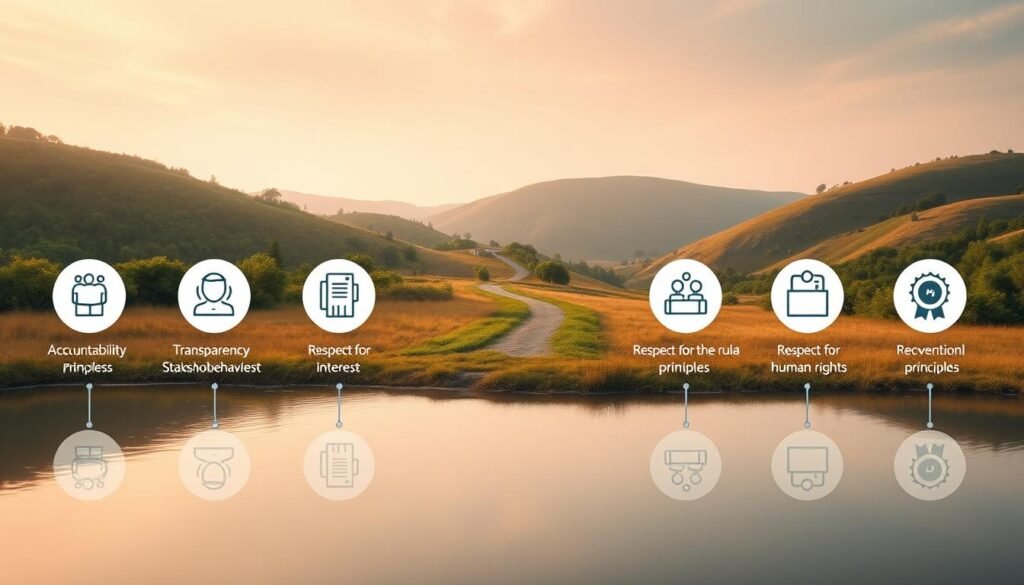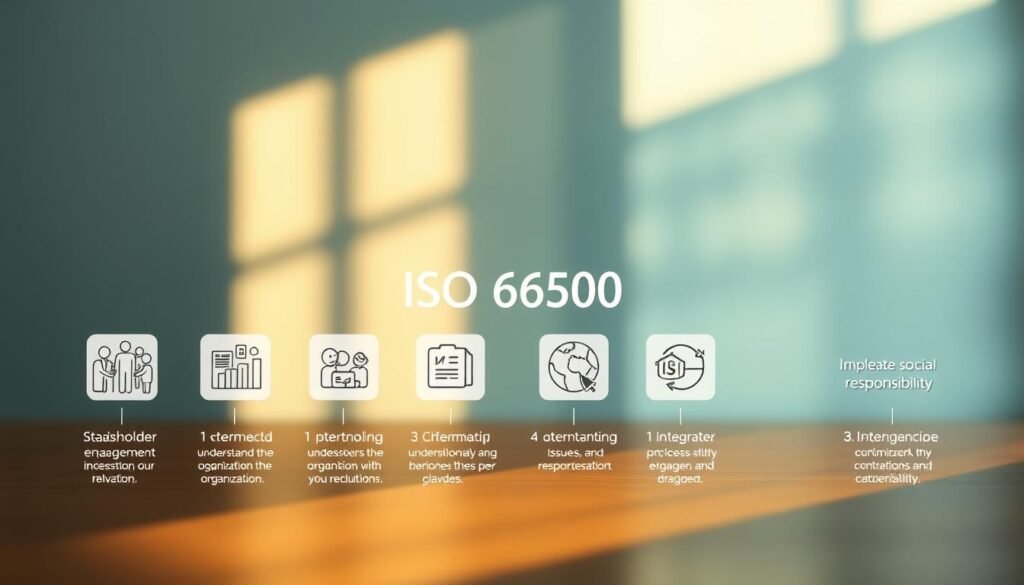What if your company could do more than just make money? What if it could also make a real difference in the world?
Many businesses today want to be good citizens. They aim to help people and protect our planet. This idea is called social responsibility.
There is a special standard to guide them. It is called ISO 26000. This framework helps all kinds of groups act responsibly.
It covers important areas like human rights and labor practices. Big names like Coca-Cola and Starbucks use it. Over 80 countries follow its advice.
This guide is not about getting a certificate. It is about making real changes. It helps companies build trust and support sustainable development.
Key Takeaways
- ISO 26000 is a global guide for social responsibility, not a certification.
- It helps organizations of all sizes integrate ethical practices into their operations.
- The standard covers seven core subjects, including human rights and fair operating practices.
- Over 80 countries have adopted it, including major economies like the U.S. and Germany.
- Leading global companies use this framework to align with sustainable development goals.
- It encourages going beyond legal requirements to make a positive community impact.
- Implementation builds stakeholder trust and promotes long-term business success.
What is the ISO 26000 Standard?
Organizations worldwide seek a clear path to responsible operations. The ISO 26000 standard offers that guidance. It helps groups make ethical choices that benefit society.
Defining Social Responsibility According to ISO
Social responsibility means a company owns its impact on people and the planet. It acts with honesty and openness. This behavior supports sustainable development and follows the law.
It also listens to what stakeholders expect. The goal is to match global norms of behavior. This approach builds trust and shows real commitment.
The Development and Global Adoption of ISO 26000
Creating this guide took five years of hard work. About 500 experts from six groups joined in. They came from industry, government, and non-profits.
Labor and consumer reps also took part. So did academics and consultants. This mix ensured views from both rich and poor nations.
The standard is voluntary. Any group can use it, big or small. It does not give certification like other ISO rules.
Over 80 countries now use this framework. It helps them focus on key areas like human rights and fair labor practices. Companies learn to care for customers, workers, and communities.
Why ISO 26000 Was Created: Addressing the Need for CSR
Different industries and regions approached social responsibility in wildly different ways. This created confusion across global business operations.
Companies in various sectors had unique challenges. Geographic location influenced their practices too. Government regulations added another layer of complexity.
The ISO 26000 standard emerged to solve this problem. It offered a clear path for all organizations. This guidance helped them become better corporate citizens.
Many groups followed CSR as a voluntary effort. The framework encouraged moving beyond basic compliance. It promoted meaningful contributions to society.
A significant gap existed in consistent implementation worldwide. The same social responsibility principles were applied differently. This standard filled that critical need.
The guidance respects cultural and societal differences. It acknowledges various economic conditions too. Legal and environmental factors are also considered.
Any organization can use this comprehensive framework. It works for businesses of all sizes and types. Location does not limit its effectiveness.
Companies learn to turn ethical principles into real actions. They develop effective strategies for community impact. This creates tangible benefits for all stakeholders.
The standard facilitates sharing of international best practices. Organizations learn from global success stories. This improves CSR implementation everywhere.
A globally recognized approach ensures consistency. All companies follow the same core guidelines. This builds trust with customers and communities.
Modern stakeholders expect better social performance from organizations. The ISO 26000 addresses these evolving expectations directly. It helps businesses meet rising standards of responsibility.
The 7 Foundational Principles of Social Responsibility
Every great structure needs a solid foundation. The same is true for responsible business practices.
These seven core principles form the bedrock of genuine social commitment. They guide organizations toward meaningful action and lasting impact.
Accountability
Companies must own their impact on society and the environment. This means creating clear channels for reporting issues.
Regular audits help assess and correct social and environmental effects. Organizations show they take responsibility seriously.
Transparency
Open communication builds trust with everyone involved. Companies share their policies, practices, and performance data openly.
This includes environmental efforts and labor conditions. Honest reporting shows real commitment to improvement.
Ethical Behaviour
Good conduct goes beyond basic rules. It means fighting corruption and ensuring product safety.
Fair labor practices and honest decision-making matter most. Integrity becomes part of everyday business.
Respect for Stakeholder Interests
Understanding diverse needs leads to better outcomes. Engaging with stakeholders helps identify what matters most.
Involving them in decisions creates stronger relationships. Their feedback shapes more effective strategies.
Respect for the Rule of Law
Following local and international laws maintains legitimacy. Compliance reduces legal risks and builds community trust.
Legal obedience forms the minimum standard for operations. It provides the framework for all other actions.
Respect for International Norms of Behavior
Global standards create consistency across borders. Embracing best practices improves social responsibility efforts.
This approach aligns with worldwide expectations. It demonstrates commitment beyond local requirements.
Respect for Human Rights
Protecting rights across all activities is fundamental. Fair treatment of employees shows genuine care.
Safeguarding against discrimination ensures dignity for all. Community rights receive equal attention and protection.
These principles serve as guiding values for all initiatives. They help organizations build a culture of true responsibility.
Practical implementation varies by context but follows these core ideas. Each principle translates into specific actions and policies.
Exploring the 7 Core Subjects of ISO 26000
Companies face many areas where they can make a difference. The ISO 26000 framework identifies seven key topics for action.
These subjects help organizations focus their efforts where they matter most. Each area contains specific issues that need attention.
Organizational Governance
Good governance means making clear and fair decisions. It creates systems that ensure accountability at all levels.
Transparent processes help build trust with everyone involved. This foundation supports all other social responsibility efforts.
Human Rights
Every person deserves basic rights and fair treatment. Companies must fight discrimination in all its forms.
Workers should enjoy proper working conditions and equal opportunities. Respecting civil and political rights shows real commitment.
Labor Practices
Fair employment relationships form the heart of good business. Proper working conditions keep employees safe and valued.
Health and safety programs protect workers from harm. Social protection and training help people grow in their careers.
The Environment
Businesses must care for our planet through their actions. Preventing pollution reduces harm to air, water, and land.
Sustainable resource use protects nature for future generations. Climate change efforts and biodiversity protection matter greatly.
Fair Operating Practices
Honest business conduct builds strong reputations. Anti-corruption measures ensure clean operations.
Fair competition creates equal opportunities for all companies. Respect for property rights supports innovation and growth.
Consumer Issues
Customers deserve truthful marketing and safe products. Privacy protection keeps personal information secure.
Sustainable consumption choices help protect the environment. Consumer education empowers people to make smart decisions.
Community Involvement and Development
Local communities benefit from company engagement. Job creation provides economic stability for families.
Education support helps build brighter futures for young people. Health promotion and technology development strengthen societies.
These seven subjects work together with the core principles. They provide practical ways to implement social responsibility.
Organizations like Association of Upper Egypt for Education show how it works. They focus on education and community development.
NCA Rouiba demonstrates environmental responsibility in their operations. They manage resources wisely and reduce waste.
Each company must choose which issues fit their situation best. The framework offers guidance without being rigid.
This approach creates meaningful change where it counts most. It turns good intentions into real results for people and planet.
How ISO 26000 Differs from Other Standards and Frameworks
Many organizations wonder how this guidance compares to other approaches. The answer reveals why this framework stands apart in meaningful ways.
A Voluntary Guideline, Not a Certifiable Standard
This framework offers recommendations rather than strict requirements. Unlike other management systems, it does not lead to formal certification.
Organizations cannot use it for audits or compliance statements. It focuses on guidance rather than checking boxes.
Compare this to environmental or quality management standards. Those systems require specific documentation and verification processes.
This approach emphasizes integration into daily operations. Companies build social responsibility into their culture rather than seeking a certificate.
Universal Applicability Across Organizations and Sectors
The guidance works for any type of organization worldwide. A small non-profit can use it as effectively as a large corporation.
Schools, hospitals, and government agencies all benefit equally. The framework adapts to different contexts and needs.
Sector-specific standards focus on particular industries. This guidance covers all aspects of organizational responsibility.
It addresses social, environmental, and economic dimensions together. This holistic view supports true sustainable development.
The approach encourages continuous improvement over time. Organizations develop better practices through ongoing effort.
This flexibility makes it valuable across diverse settings. Each company can apply the principles in their own way.
A Step-by-Step Guide to Implementing ISO 26000
Turning principles into action requires a clear roadmap. This implementation process helps organizations build meaningful social responsibility programs.
Each step builds upon the previous one. Together they create a comprehensive approach to responsible business practices.
Step 1: Educate and Build Internal Understanding
Start with comprehensive education for your team. Interactive online modules make learning engaging and accessible.
Workshops allow for deeper discussion of complex topics. Case studies show real-world applications of the principles.
Discussion forums encourage employee participation. This creates a shared understanding across the organization.
Step 2: Conduct a Situational Diagnostic and Landscape Analysis
Assess your current position through thorough evaluation. Internal experts understand your operations best.
External consultants bring fresh perspectives and industry knowledge. Surveys gather valuable input from various sources.
Interviews provide detailed qualitative information. Cross-functional teams ensure comprehensive analysis.
Create an inventory of current practices and impacts. Document stakeholder relationships and existing commitments.
Step 3: Identify and Prioritize Relevant Issues
The framework includes 37 specific issues for consideration. Not all will be equally important for your organization.
Cost-benefit analysis helps determine resource allocation. SMART goal setting ensures measurable outcomes.
Focus on issues that align with your core business activities. Prioritize areas where you can make the most significant impact.
Step 4: Identify and Engage Your Stakeholders
Develop clear engagement plans for different groups. Use multiple communication channels for maximum reach.
Meetings allow for direct conversation and feedback. Surveys gather quantitative data from larger audiences.
Focus groups provide in-depth qualitative insights. Regular feedback mechanisms maintain ongoing dialogue.
Understand stakeholder expectations and concerns. Their input shapes more effective social responsibility strategies.
Step 5: Develop and Resource Your Improvement Plans
Identify weaknesses and opportunities for improvement. Allocate necessary resources for successful implementation.
Create detailed action plans with clear timelines. Assign responsibilities to specific team members.
Integrate new practices into daily operations. Provide training for employees at all levels.
Ensure adequate budget and personnel support. This commitment demonstrates serious dedication to improvement.
Step 6: Establish Transparent Public Reporting
Use standardized templates for consistent reporting. Include both quantitative and qualitative data.
Follow established frameworks like GRI for credibility. Share both successes and areas for improvement.
Transparent reporting builds trust with stakeholders. It shows your commitment to honest communication.
Regular reports demonstrate ongoing progress. They provide accountability for your social responsibility efforts.
Step 7: Foster a Culture of Open Communication
Create regular channels for internal and external dialogue. Town hall meetings allow for company-wide updates.
Responsive dialogue addresses concerns promptly. Quick issue resolution shows respect for stakeholder input.
Open communication becomes part of your organizational culture. It supports continuous improvement and adaptation.
This approach turns the ISO 26000 guidance into living practice. It creates lasting positive impact for your business and community.
The Tangible Benefits of Adopting ISO 26000
Companies gain real advantages when they follow responsible business practices. These benefits go beyond simple compliance and create lasting value.
Organizations see improvements in multiple areas of their operations. The social responsibility framework helps them achieve measurable results.
Businesses build stronger relationships with their communities. They also improve their internal operations and external reputation.
Enhanced Reputation and Competitive Advantage
Companies that demonstrate real commitment earn greater trust. Customers prefer businesses that act responsibly.
This trust translates into better brand perception. Organizations stand out from their competitors in meaningful ways.
Ethical consumers choose companies aligned with their values. This creates a distinct competitive advantage in the marketplace.
Investors also notice strong social performance. They see it as a sign of good management and long-term thinking.
Improved Risk Management and Employee Satisfaction
Following the standard helps identify potential problems early. Companies address issues before they become major concerns.
Legal compliance becomes easier with clear guidelines. Organizations avoid penalties and maintain their good standing.
Employees feel proud working for responsible companies. This pride boosts morale and increases job satisfaction.
Workers stay longer with employers who treat them well. Retention improves when companies show genuine care for their team.
These benefits create a positive cycle of improvement. Better workplaces attract better talent and serve customers better.
The framework supports sustainable business growth. Companies build resilience against market changes and challenges.
Economic performance often improves with stronger reputation. Responsible practices lead to better long-term results.
ISO 26000’s Role in Sustainable Development and the UN SDGs
Global organizations seek meaningful ways to support worldwide progress. The ISO 26000 framework provides clear guidance for this important work.
It helps companies connect their daily operations with bigger global goals. This approach creates real impact where it matters most.
The standard offers over 450 specific recommendations. These cover all seven core subjects and foundational principles.
Each suggestion addresses particular United Nations Sustainable Development Goals. This creates a direct link between business actions and global needs.
Poverty reduction receives strong attention through fair labor practices. Companies learn to provide living wages and safe working conditions.
Gender equality gets support through anti-discrimination policies. Organizations ensure equal opportunities for all employees.
Environmental sustainability features prominently throughout the guidance. Businesses learn to reduce waste and protect natural resources.
Climate action becomes part of regular operations. Companies contribute to a healthier planet through their choices.
The framework aligns with international human rights conventions. It supports social justice through respectful treatment of all people.
Economic growth gets boosted through responsible business behavior. Fair competition and ethical practices create stronger markets.
Community development receives special focus. Local job creation and education support build brighter futures.
Stakeholder engagement ensures all voices get heard. This leads to more effective and inclusive solutions.
Implementation helps balance environmental, social, and economic needs. Organizations learn to consider all three aspects together.
This holistic approach supports the UN’s Agenda 2030 vision. Companies become partners in global progress.
Responsible behavior gets integrated throughout all operations. It becomes part of how business gets done every day.
Relationships with suppliers and customers reflect these values. The entire business ecosystem benefits from this approach.
Long-term societal well-being becomes a central focus. Environmental health receives equal attention and care.
This comprehensive view of social responsibility creates lasting positive change. It turns global goals into local actions.
Conclusion: Integrating Social Responsibility for Long-Term Success
Social responsibility is more than a trend—it’s a strategic advantage. The ISO 26000 framework offers clear, actionable guidance for any organization.
It respects cultural, environmental, and legal differences. This approach helps businesses implement strong principles and improve continuously.
Stakeholder communication builds trust and supports reliable reporting. Proper phrasing like “using ISO 26000 as a guide” clarifies your commitment without implying certification.
Integrating these practices enhances reputation, manages risk, and drives competitive advantage. Balancing business goals with societal and environmental needs ensures lasting success and meaningful impact.
FAQ
What is the ISO 26000 standard?
It’s a voluntary international guideline that helps organizations operate in a socially responsible way. It provides a framework for integrating ethical behavior, transparency, and respect for stakeholders into business strategies.
Is ISO 26000 a certifiable standard?
No, it is not a certification standard. It serves as guidance to help companies improve their social responsibility performance rather than as a requirement for audit or certification.
What are the core subjects covered by ISO 26000?
The standard addresses seven core subjects: organizational governance, human rights, labor practices, the environment, fair operating practices, consumer issues, and community involvement and development.
How does ISO 26000 relate to sustainable development?
It supports the United Nations Sustainable Development Goals by encouraging businesses to contribute positively to society and the environment through responsible operations and long-term planning.
Can any organization use ISO 26000?
Yes, it applies universally to all types of organizations—public, private, and nonprofit—regardless of size, sector, or location.
What are the benefits of implementing ISO 26000?
Benefits include improved reputation, better risk management, increased employee satisfaction, stronger stakeholder relationships, and a competitive advantage in the marketplace.







